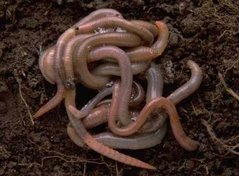Annelids move by using the two (major) sets of muscles they have. The set of muscles that run from the anterior of the worm to the posterior are called longitudinal muscles, while the other set (circular) is set like a coil on the inside of the worm.
When the longitudinal muscles contract, they make the worm shorter, and when the circular set conracts, the annelid elongates. Aquatic annelids (most Polychaetes) make use of this to slowly make their way through the water, while underground annelids force through moist soil with this method of movement.
Polychaetae and Oligochaetae also move through the use of their Chaetae (sing. Chaeta). It has also been named Seta(e), but Chaeta applies to annelids specifically. Chaetae are bristle-like organic structures that are found on the topmost layer of skin. They are withdrawn when the body is extending, and allow for the Poly/Oligochaetae to have a better form of grip on the surface they are on, though Oligochaetae use this particular function more often.
 Anyone else think these Chaetae look like crab legs?
Anyone else think these Chaetae look like crab legs?Polychaetae have Parapodia, laterally paired appendages mainly used for creating currents, swimming and digging.

Parapodia~!

No comments:
Post a Comment